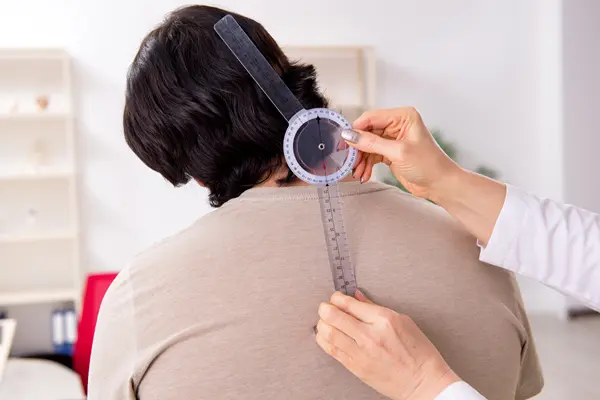Have you ever experienced an unexpected dizzy spell, leaving you feeling disoriented or unsteady on your feet? If so, you may be dealing with a condition known as cervical vertigo. This form of vertigo (dizziness) stems from issues in the neck (cervical spine). It can cause dizziness, loss of balance, and nausea. It’s an uncomfortable and alarming experience. Cervical vertigo interferes with daily life, making even simple tasks like walking or driving difficult.
As the name implies, cervical vertigo is triggered by issues in the cervical spine. When blood flow or nerve function to the head is disrupted, it can cause episodes of dizziness or lightheadedness. If you live in Arvada, Denver, or Wheat Ridge, Colorado, and suffer from these symptoms, we have an effective, natural solution that doesn’t rely on medication to mask the issue.
At Integrative Health and Rehabilitation, led by Dr. James Doran, DC, we understand how debilitating cervical vertigo can be. With over 25 years of experience as a chiropractor and 20 years as a certified chiropractic acupuncturist, Dr. Doran has helped countless patients regain their balance, reduce dizziness, and enjoy life without depending on medications. Chiropractic care and acupuncture offer natural, proven solutions to treat the root causes of cervical vertigo—providing lasting relief without harmful side effects.
Explore how chiropractic and acupuncture work together to treat cervical vertigo, relieve symptoms of dizziness, and help you find long-term relief from this frustrating condition.
Table of Contents
ToggleUnderstanding Cervical Vertigo Symptoms
Recognizing the symptoms of cervical vertigo is essential to understanding it. Unlike other types of vertigo, which are often related to problems in the inner ear, cervical vertigo is directly linked to issues in the neck. These issues can disrupt signals sent between the cervical spine and the brain, leading to symptoms ranging from mildly bothersome to downright debilitating.
Common Cervical Vertigo Symptoms
- Dizziness: A sensation of spinning or feeling off-balance, especially after moving the head or neck. This can happen suddenly and last for a few seconds or linger longer.
- Unsteadiness: People with cervical vertigo often feel swaying or lose balance when standing or walking.
- Nausea: Dizziness and vertigo often come hand-in-hand with feelings of nausea, sometimes severe enough to affect appetite or cause vomiting.
- Headaches: Pain, tightness, or pressure in the head or neck is common in those suffering from cervical vertigo, particularly after periods of sitting or standing in one position for too long.
- Blurred vision or difficulty focusing: Cervical vertigo can affect visual perception, making it hard to focus on objects or read text.
- Ringing in the ears (tinnitus): Some individuals experience ringing or buzzing in their ears, which can further exacerbate vertigo episodes.
These symptoms can make everyday activities feel overwhelming. Simple things like turning your head to look behind you, bending down, or getting up too quickly can trigger an episode. If you’re dealing with cervical vertigo symptoms, it’s understandable that you want a solution that gets to the root of the problem.
Unfortunately, many conventional treatments, such as medications, mask the symptoms without addressing the underlying cause. While medicines like anti-nausea or anti-dizziness drugs might provide short-term relief, they don’t correct the misalignments or nerve issues that cause cervical vertigo. This is why chiropractic care and acupuncture have become increasingly popular treatments. They offer a natural, effective way to target the condition’s root cause by restoring alignment and balance in the body.
Causes of Cervical Vertigo
We must dive into the relationship between the neck and the brain to understand how cervical vertigo develops. The cervical spine (the uppermost part of your spine) is crucial in maintaining balance and coordination, primarily because of its close connection with the brainstem, spinal cord, and the body’s vestibular system. When something goes wrong in this part of the spine, it can trigger episodes of vertigo and other symptoms.
Primary Causes of Cervical Vertigo
- Trauma or injury: Whiplash from car accidents, sports injuries, or even sudden, jarring movements can lead to misalignment in the neck. This can irritate the nerves responsible for transmitting signals between the body and the brain, resulting in dizziness and imbalance.
- Poor posture: Many people, especially those who work at desks for long periods, develop poor posture. Slouching or craning the neck forward puts undue stress on the cervical spine, leading to structural issues that trigger cervical vertigo.
- Degenerative disc disease or arthritis: As we age, the discs between our vertebrae can break down, and the joints can develop arthritis. These changes put pressure on the nerves and blood vessels in the neck, potentially affecting blood flow to the brain and contributing to dizziness.
- Muscle tension and spasms: Tight, tense muscles in the neck—whether from stress, poor posture, or overuse—can pressure nerves and even reduce proper blood flow to the brain, resulting in vertigo-like symptoms.
When the cervical spine isn’t aligned correctly, or there’s tension in the surrounding muscles, it can affect the vestibular system, which maintains balance and spatial orientation. This system relies on clear communication between the body’s muscles, joints, and brain to help you stay upright and oriented in your environment. When interference with this communication—often due to nerve compression or blood flow issues caused by neck problems—disrupts your sense of balance, resulting in the characteristic dizziness of cervical vertigo.
Unlike other treatments that relieve dizziness, chiropractic care and acupuncture target these underlying causes. Chiropractic adjustments work to realign the spine, freeing up nerve pathways and improving blood flow. Similarly, acupuncture reduces tension and inflammation while encouraging the body’s natural healing processes.
 Chiropractic Treatment for Cervical Vertigo
Chiropractic Treatment for Cervical Vertigo
When treating cervical vertigo, chiropractic care offers a natural and highly effective solution by directly addressing the root causes of the condition—misalignment, nerve compression, and muscle tension in the cervical spine. Unlike medications, which only mask the symptoms, chiropractic adjustments restore proper alignment and function, providing long-term relief from vertigo symptoms.
At Integrative Health and Rehabilitation, Dr. James Doran has been helping patients with cervical vertigo for over 25 years. As an experienced Denver chiropractor, Dr. Doran creates personalized treatment plans targeting each patient’s unique condition. For cervical vertigo, chiropractic adjustments are often the key to realigning the spine and relieving the pressure contributing to dizziness, balance problems, and other symptoms.
How Chiropractic Can Help Cervical Vertigo
Spinal Adjustments
The core of chiropractic treatment for cervical vertigo involves spinal adjustments. Misalignments in the cervical spine—known as subluxations—can pressure the nerves that control balance and spatial orientation, leading to vertigo symptoms. Through gentle, precise adjustments, Dr. Doran restores motion to vertebrae in the neck that are “stuck” or subluxated, restoring normal nerve function and relieving the pressure on the spinal nerves that contribute to dizziness.
These adjustments not only alleviate vertigo but also help improve posture, reduce muscle tension, and enhance the overall function of the nervous system. Many patients experience immediate relief after an adjustment, while others may require multiple sessions to recover fully.
Dry Needling and Low-Level Laser Therapy
In addition to spinal adjustments, dry needling can release trigger points and relieve muscle tension in the neck. Tight muscles can restrict blood flow and irritate nerves, worsening vertigo symptoms. Dry needling involves using thin needles to target these tense areas, helping the muscles relax and improving circulation.
Similarly, low-level laser therapy (LLLT) is a non-invasive treatment that uses light energy to reduce inflammation and promote healing in the affected area. LLLT can enhance the effects of chiropractic adjustments by further reducing nerve irritation and muscle tension, allowing the body to heal more effectively.
Shockwave Therapy
For some patients, shockwave therapy may be an effective complementary treatment. This non-invasive therapy uses sound waves to stimulate healing and repair in the muscles and tissues surrounding the cervical spine. Shockwave therapy helps relieve the underlying issues contributing to cervical vertigo by promoting blood flow and reducing muscle stiffness.
Postural and Lifestyle Adjustments
Chiropractic care for cervical vertigo also includes postural correction and ergonomic guidance. Poor posture, especially from prolonged sitting or desk work, can contribute to neck strain and misalignments that cause vertigo. Dr. Doran provides:
- Personalized advice on improving posture.
- Adjusting your workspace.
- Incorporating exercises that support the health of your cervical spine.
This comprehensive approach helps to prevent future vertigo episodes by addressing the underlying factors that lead to misalignment.
Acupuncture for Cervical Vertigo
While chiropractic care is crucial in addressing the structural issues behind cervical vertigo, acupuncture offers a powerful complementary treatment by targeting the body’s energy flow, reducing inflammation, and promoting nerve healing. With over 20 years of experience as a certified chiropractic acupuncturist, Dr. James Doran integrates these two approaches at Integrative Health and Rehabilitation to create comprehensive and effective treatment plans for cervical vertigo patients.
How Acupuncture Works for Cervical Vertigo
Acupuncture is an ancient practice rooted in traditional Chinese medicine that involves inserting very thin needles into specific points on the body, known as acupoints. These points are located along meridian pathways, corresponding to the body’s energy flow, or Qi. When Qi is blocked or disrupted—whether due to injury, tension, or poor circulation—it can lead to symptoms like dizziness, muscle stiffness, and imbalance, all common in cervical vertigo.
For those dealing with cervical vertigo, acupuncture works in several ways:
- Restoring balance in the body: Acupuncture helps restore the flow of Qi, which brings the body back into balance. This improved balance and energy flow can alleviate the sense of dizziness and instability that vertigo patients often experience.
- Reducing inflammation: One of the key benefits of acupuncture is its ability to reduce inflammation. This is particularly important for patients with cervical vertigo, as inflammation in the cervical spine or surrounding muscles can put pressure on nerves and blood vessels, contributing to symptoms.
- Promoting blood flow: By stimulating the acupoints, acupuncture improves blood circulation throughout the body, including the neck and head. This enhanced circulation helps to reduce the severity of dizziness and headaches by ensuring that the brain and inner ear receive the oxygen and nutrients they need.
- Relieving muscle tension: Tight, tense muscles around the neck and shoulders are often at the root of cervical vertigo symptoms. Acupuncture relaxes these muscles, reducing the pressure on nerves and blood vessels and significantly relieving vertigo-related discomfort.
Electro-Acupuncture and Advanced Techniques
Dr. Doran uses advanced electro-acupuncture techniques at Integrative Health and Rehabilitation to enhance treatment outcomes. Electro-acupuncture involves sending small electrical impulses through the acupuncture needles to stimulate the muscles and nerves further. This technique is particularly effective for reducing chronic muscle tension and improving nerve function, both critical in treating cervical vertigo.
The gentle stimulation from electro-acupuncture can help:
- Reduce chronic pain and muscle tightness in the neck.
- Improve nerve communication between the cervical spine and the brain, often disrupted in cervical vertigo.
- Speed up recovery from injuries or trauma that may have caused the vertigo.
The Combination of Acupuncture and Chiropractic Care
While chiropractic care focuses on realigning the cervical spine and relieving nerve pressure, acupuncture works in tandem to promote healing, reduce tension, and restore the body’s natural balance. Together, these therapies create a holistic approach to cervical vertigo treatment, addressing the structural and energetic imbalances contributing to the condition.
This combination of therapies accelerates recovery and provides many patients with a more comprehensive treatment solution. Rather than relying on medications that only offer temporary relief, acupuncture and chiropractic care provide a lasting solution to the issues that cause cervical vertigo.
By choosing Integrative Health and Rehabilitation, patients in Arvada, Denver, and Wheat Ridge can experience the benefits of these two complementary therapies tailored to their conditions and needs.
If you’re ready to try acupuncture alongside chiropractic care for your cervical vertigo, contact us today to schedule an appointment. We’re here to help you feel better—naturally and holistically.
Misconceptions About Chiropractic and Acupuncture
Many people hesitate to explore chiropractic care and acupuncture for treating conditions like cervical vertigo due to common misconceptions. These natural therapies are often misunderstood, leading some to dismiss them as unproven or ineffective. However, both chiropractic care and acupuncture have decades of scientific backing and have helped countless patients find relief from chronic conditions without relying on medications.
Let’s clear up a few of the most common misconceptions and explain why these treatments are safe, effective, and often superior to traditional approaches that only mask cervical vertigo symptoms.
Misconception #1: Chiropractic Adjustments Are Painful
One of the biggest misconceptions about chiropractic care is that it’s painful or dangerous. People often associate spinal adjustments with cracking or popping sounds, making them nervous. Chiropractic adjustments are gentle, precise, and tailored to each patient’s comfort level. The goal is to correct misalignments in the spine, particularly in the neck, to relieve pressure on the nerves and restore the body’s natural balance.
Dr. James Doran uses specific techniques to effectively and comfortably realign the cervical spine for patients with cervical vertigo. Many patients feel immediate relief from dizziness and tension after an adjustment, and any initial discomfort is usually minimal and short-lived.
Misconception #2: Acupuncture Is Uncomfortable or Risky
Acupuncture involves the use of very thin, sterile needles, and the thought of needles can understandably cause hesitation for some. However, acupuncture needles are much thinner than those used for injections, and most patients feel little to no discomfort during the procedure. In fact, many describe the sensation as relaxing, with some patients even falling asleep during treatment!
More importantly, acupuncture is a highly safe and low-risk treatment when performed by a certified practitioner like Dr. Doran, who has more than 20 years of experience in chiropractic acupuncture. The needles are placed precisely to stimulate the body’s natural healing processes, reduce inflammation, and promote better nerve function—none of which can be achieved through conventional medications.
Misconception #3: Chiropractic and Acupuncture Only Address Symptoms
A common misconception is that chiropractic care and acupuncture provide temporary relief or only treat symptoms, similar to medications. However, both treatments go beyond symptom management by addressing the underlying causes of cervical vertigo.
Spinal adjustments correct the misalignments in the cervical spine that impair nerve function and disrupt the balance. Acupuncture, on the other hand, restores the flow of energy (Qi) and improves circulation, allowing the body to heal itself naturally. Together, these treatments correct the physiological imbalances contributing to vertigo, providing long-term relief rather than a quick fix.
Misconception #4: Medications Are More Effective Than Natural Treatments
Many people turn to medications like anti-dizziness drugs or anti-inflammatories when they first experience vertigo. While these drugs can temporarily relieve cervical vertigo symptoms, they do not address the root cause of the problem. Over time, reliance on medications can lead to unwanted side effects, including drowsiness, digestive issues, or even dependency, without resolving the underlying cervical spine issues.
Conversely, chiropractic care and acupuncture offer a natural and holistic alternative to medication. By focusing on spinal health and the body’s energy balance, these therapies work together to treat the root causes of vertigo. This results in longer-lasting relief, fewer side effects, and a healthier, more balanced body.
Misconception #5: Only Surgery Can Fix Cervical Spine Issues
Some patients are led to believe that surgery is the only way to fix cervical spine problems. While surgery may be necessary in extreme cases, it is often avoidable with early intervention through chiropractic care and acupuncture. These treatments can prevent the need for invasive procedures by correcting misalignments and relieving nerve pressure naturally.
At Integrative Health and Rehabilitation, Dr. Doran has helped many patients avoid surgery through his integrated approach. Chiropractic and acupuncture work together to relieve pressure on the nerves, reduce inflammation, and promote healing, giving the body the support it needs to recover without surgical intervention.
The truth is that Chiropractic and Acupuncture are safe, natural, and highly effective treatments for cervical vertigo.
Nutritional Support for Cervical Vertigo
In addition to chiropractic care and acupuncture, proper nutrition can be vital in managing cervical vertigo and supporting your body’s healing process. While vertigo is often linked to structural issues in the cervical spine, certain dietary habits can contribute to or alleviate the symptoms associated with this condition. A nutrient-rich, anti-inflammatory diet can help reduce inflammation, improve circulation, and maintain balance within the body.
At Integrative Health and Rehabilitation, we emphasize a holistic approach to treatment. This means examining how lifestyle factors, including nutrition, impact your health. Here are some nutritional strategies that can help support your recovery from cervical vertigo:
Anti-Inflammatory Foods
Inflammation is one of the primary contributors to both cervical spine discomfort and the nerve irritation that triggers vertigo symptoms. By including more anti-inflammatory foods in your diet, you can help reduce overall inflammation and improve your body’s healing ability. These foods include:
- Omega-3 fatty acids: Omega-3s are found in fatty fish like salmon, mackerel, and sardines and are known for their potent anti-inflammatory effects. Flaxseeds, chia seeds, and walnuts are also excellent plant-based sources.
- Leafy greens: Vegetables like spinach, kale, and arugula contain antioxidants and vitamins that combat inflammation.
- Berries: Blueberries, strawberries, and blackberries are loaded with antioxidants called flavonoids, which reduce inflammation and support brain and nerve health.
- Turmeric: This bright yellow spice contains curcumin. This potent anti-inflammatory compound can help reduce inflammation in the cervical spine.
Incorporating these foods into your daily meals can help combat the chronic inflammation that often contributes to cervical vertigo symptoms.
Proper Hydration
Staying hydrated is essential for anyone with vertigo. Dehydration can worsen dizziness by lowering blood volume and viscosity and reducing blood flow to the brain. Proper hydration ensures optimal brain and body function, helping to maintain balance and reduce the episodes of vertigo.
Try to drink at least eight glasses of water daily, and more if you’re physically active or live in a dry climate like Colorado. Avoid excessive consumption of diuretics like caffeine and alcohol, which can contribute to dehydration.
Magnesium-Rich Foods
Magnesium is an essential mineral that supports healthy nerve function and helps to relax tight muscles, which can benefit people with cervical vertigo. Tension and spasms in the neck muscles are common contributors to vertigo symptoms. Proper magnesium levels in your diet can help alleviate some of this tension.
Magnesium-rich foods include:
- Almonds
- Spinach
- Avocados
- Pumpkin seeds
- Bananas
Adding these foods to your diet can support muscle relaxation and improve nerve function, potentially reducing your symptoms.
Vitamin D and Bone Health
Maintaining the health of your cervical spine is essential in managing cervical vertigo. Vitamin D plays a vital role in bone health and helps the body absorb calcium, strengthening the vertebrae and joints. Low vitamin D levels are associated with an increased risk of bone and joint issues. These problems in turn exacerbate spinal misalignments, contributing to vertigo symptoms.
Foods rich in vitamin D include:
- Fortified dairy products
- Egg yolks
- Fatty fish like salmon and tuna
Additionally, moderate exposure to sunlight helps the body produce its own vitamin D, so spending time outdoors can be beneficial.
Reducing Processed Foods and Sugars
Highly processed foods and refined sugars contribute to inflammation and can worsen dizziness and other cervical vertigo symptoms. Processed foods are often low in nutrients and high in sodium, sugar, and unhealthy fats. This type of diet can interfere with proper circulation and nerve function.
Limiting your processed, fast, and sugary snack intake can reduce inflammation and support your body’s overall healing process.
Focusing on a diet rich in anti-inflammatory foods, staying hydrated, and supporting bone and muscle health with the proper nutrients can enhance the effects of your chiropractic and acupuncture treatments. We believe in combining natural therapies with nutritional support to relieve cervical vertigo.
Schedule a consultation for personalized advice on nutrition and how it can relieve your symptoms of cervical vertigo.
Why Choose Integrative Health and Rehabilitation?
If you’ve been struggling with cervical vertigo, finding the proper treatment can feel overwhelming. Conventional options often rely on medications that only mask symptoms, leaving you without a long-term solution. At Integrative Health and Rehabilitation, we take a different approach by addressing the root causes of vertigo through chiropractic care, acupuncture, and holistic therapies that promote lasting relief.
Expert Care
With almost three decades of experience as a chiropractor and certified chiropractic acupuncturist, Dr. James Doran is a trusted expert in treating cervical vertigo. His extensive knowledge and expertise allow him to provide personalized care tailored to each patient’s needs.
Dr. Doran uses a combination of chiropractic adjustments and acupuncture to restore alignment in the cervical spine, relieve pressure on nerves, and promote balance within the body. Undeniably, targeting the causes of cervical vertigo offers a natural, drug-free solution to help you regain control of your life.
Comprehensive Treatment Options
Integrative Health and Rehabilitation offers various therapies that complement chiropractic care and acupuncture. In addition to spinal adjustments and traditional acupuncture, we provide advanced treatments such as:
- Dry Needling: Used to relieve muscle tension and improve blood flow, reducing the discomfort caused by tight neck muscles.
- Electro-Acupuncture: Acupuncture combined with electrical stimulation for chronic conditions like cervical vertigo.
- Low-Level Laser Therapy: This non-invasive treatment reduces inflammation and accelerates healing by stimulating cell repair in damaged tissues.
- Shockwave Therapy: This therapy uses sound waves to promote healing in tissues and muscles, enhance blood flow, and reduce tightness.
- IonCleanse Detoxifying Footbath: A holistic therapy that helps detoxify the body, potentially reducing inflammation and improving overall health.
These therapies work in synergy to enhance the effectiveness of Chiropractic and Acupuncture. We aim to give patients the best chance of achieving long-term relief from their cervical vertigo symptoms.
Convenient Location and Personalized Care
Our clinic is conveniently located near I-70, making it easily accessible for residents of Arvada, Denver, and Wheat Ridge. Whether seeking Chiropractic care, Acupuncture, or a combination, we provide compassionate and professional care.
We pride ourselves on providing personalized, patient-centered care. From the moment you walk through our doors, we take the time to understand your symptoms, evaluate the root causes of your cervical vertigo, and design a treatment plan for you. We aim to treat your vertigo symptoms and help you achieve lasting wellness.
Treat the Cause of Your Cervical Vertigo
Are you tired of living with the dizziness, headaches, and imbalance that come with cervical vertigo? Explore treatment options that focus on addressing the cause of your condition. At Integrative Health and Rehabilitation, we combine various holistic therapies to help you feel better naturally. Never using dangerous medications or invasive procedures. If you experience cervical vertigo, contact us today to schedule an appointment.
Doctor Doran has over 25 years of experience treating back pain, neck pain, and headaches. Schedule a free consultation at our affordable chiropractic clinic with the Chiropractor Denver seeks for fast, effective, and lasting pain relief. Let us help you get back to living your best life.

Ready for an expert opinion? Get in touch today!
With a legacy of more than 25 years, our team specializes in helping individuals triumph over back pain, neck discomfort, and persistent headaches, all without relying on addictive medications or risky surgical procedures.



 Chiropractic Treatment for Cervical Vertigo
Chiropractic Treatment for Cervical Vertigo

